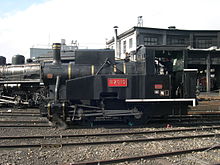Kyoto Railway Museum
The Kyōto Railway Museum ( 京都 鉄 道 博物館Kyōto Tetsudō Hakubutsukan ) is a railway museum in the Japanese city of Kyoto . It has been called that officially since the renovation and reopening in 2016. It is better known by its original name, " Umekoji Steam Locomotive Museum " ( 梅 小路 蒸 気 機関 車 館 Umekōji Jōkikikansha-kan , English Umekoji Steam Locomotive Museum ). JR West has been the operating company since the Japanese State Railways were partially privatized in 1987 .
history
The museum is located in the area of a repair shop that was first created in 1877 and expanded in 1914 to become a node for the Tōkaidō main line . Central is the roundhouse with a turntable.
When the final end of steam operation in Japan was foreseeable, the state railway decided to keep various steam locomotives. Twelve thousand guests came to the opening on October 17, 1972, in the year of the 100th anniversary of the railway in Japan.
In 2013, expansion began. Many of the exhibits on display in the Kōtsū Kagaku Hakubutsukan ( 交通 交通 博物館English Modern Transportation Museum ) in Osaka until 2014 , including units of the first Shinkansen generation , have been on display here since 2016.
exhibition

In front of the actual museum building is the wooden structure of the Nijō train station ( 二条 駅 舎 ) from 1904, which was moved here in 1996. The modern exhibition building has three levels. On the ground floor there are various rail vehicles and wagons, by 2020 their number had grown to 53 for the entire museum. Smaller exhibits and models are shown on the upper levels. There are also cab simulators.
Locomotives
Right from the start, the concept was to preserve operational steam locomotives built in Japan. At first 17 locomotives were collected, fifteen of which were in a condition to be made suitable for the route again if necessary. Until 1976 the locomotives could be looked after in the Nakano depot. Money was tight for a few years, ten locomotives could be brought into operation at the Takatori depot over the years. In 2001 six (¹), in 2009 seven (²) locomotives were operational. Three times a day there are short trips over one kilometer in the museum area.
- Steam locomotives
- 9633, year of construction: 1914
- 8630, ¹ built in 1914
- DC50-140, manufactured in 1926
- C51-239 , manufactured in 1927
- C53-45, manufactured in 1928
- C55-1, manufactured in 1935
- C11-64, manufactured in 1935
- D51-1 , manufactured in 1936
- C57-1 , ¹ built in 1937, on the Yamaguchi line since 1979
- C58-1, manufactured in 1938
- D51-200, ¹ built in 1938, demonstration locomotive in the museum, occasionally on the Yamaguchi line
- C56-160, ¹ built in 1939
- B20-10, ² built in 1946
- C59-164, manufactured in 1946
- D52-468, manufactured in 1946
- C61-2, ¹ built in 1948
- C62-2 , ¹ built in 1948
Since the opening there have been added (³ from Ōsaka):
- 1994: C62-1, manufactured in 1948
- C62-26, ³ built in 1948, the most powerful Japanese steam locomotive
- C53-45
- Freight locomotives (JGR)
Adapted from Osaka:
- 230, no. 233, built in 1903, manufactured by Kisha Seizō (JP) based on an English model
- 1070, No. 1080, manufactured in 1926, Herst.Dübs and Company (GB)
- 1800, No. 1801, Bj. 1881, Manuf .: Kitson and Company (GB)
- 7100, No. 7105, manufactured in 1880, Manuf .: HK Porter , Inc. (USA)
- 8620, No. 8630, YOM 1914, Manuf .: Kisha Seizō (JP)
- Diesel locomotives
- DD61-756, manufactured in 1972
- DD54, No. 33, manufactured in 1971, with hydraulic gear and drive Made in Germany
- KiHa 81-3 ( キ ハ 81 ), ³ built in 1960
- Electric locomotives and railcars
- EF58-150, manufactured in 1958
- EF65-1, manufactured in 1965
- EF66 -25, manufactured in 1974
- EF81-103; Bj. 1974
- JNR583, Kuhane 581-35 with accompanying sleeping car
- SURONEFU25-501, in service 1989-2018
Adapted from Osaka:
- EF52-1, DC locomotive, built in 1928
- Series 80, KuHa86-001 ( ク ハ 86 ), manufactured in 1950
- Series 101, Kumoha 100, local train
- Series 103, KuHa 103-1, local train
- KuHa 489-1, manufactured in 1971
Museum train
The C57-1 locomotive, which is owned by the museum and sometimes reinforced by the D51-200, runs on the Yamaguchi line between Shin-Yamaguchi (until 2003: Ogōri) and Tsuwano about 100 days a year . The annual 50-60,000 passengers are important for tourism in the latter place with its well-preserved samurai dwellings.
For the decision in 1978 to let the museum train run on this route, it was important that it had never been electrified and that there was therefore still enough staff with specialist knowledge. There were also working turntables at both terminus stations.
See also
literature
- Tanaka, Fumio; Umekoji Steam Locomotive Museum and Steam Operations on the Yamaguchi Line; Japan Railway & Transport Review, No. 31 (June 2002), pp. 24-7
- 梅 小路 蒸 気 機関 車 館; 梅 小路 蒸 気 機関 車 館 概要; 2015
Web links
Coordinates: 34 ° 59 ′ 14 " N , 135 ° 44 ′ 35.2" E




